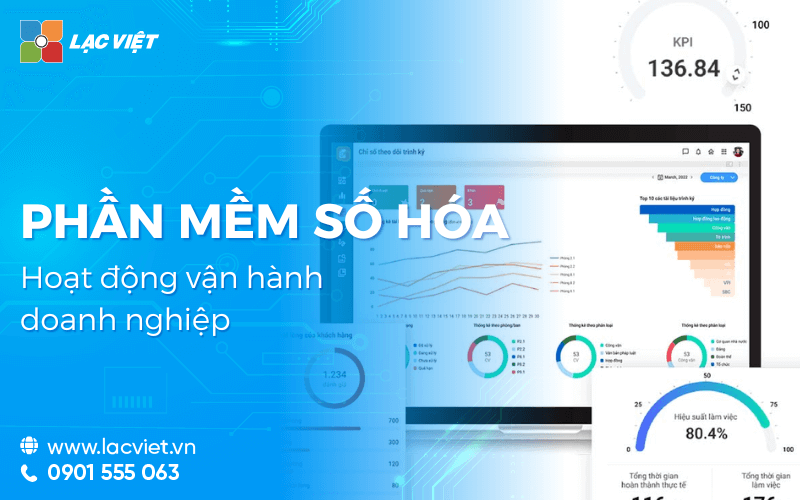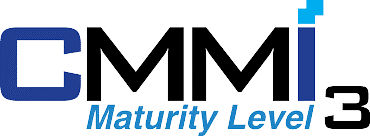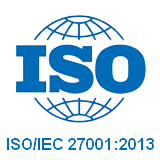Conversion of Digital Transformation (digital revolution) is becoming increasingly popular and is the model ideal activity that businesses today are directed to. If app good technology will help the business become “the lead”. Following are the steps to help your business confidently deploy Digital Transformation. Let's Lac Viet Computing find out right under article later!
Step 1: Create consensus within the leadership team
Conversion of Digital Transformation is a joint effort of the whole business, so that the final responsibility should belong to the CEO.
In a survey conducted by consulting firm Russell Reynolds Associates in 2017 of 1,500 senior executives, nearly 40% of participants said the CEO is the person responsible for implementing digital strategy at the business. . Ranked second is the Head of Marketing with 14%, followed by the Head of Digital (10%) and Head of IT (8%).
However, the CEO alone cannot manage the entire project. Implementation requires approval and support from members of senior management. This is an opportunity for directors to reconsider their role in the technology age.
The CEO can ask members of the board of directors provocative questions such as:
For CFOs: How can digitalization bring new revenue sources to businesses? How can innovation in technology improve a business's financial health?
For CIO: How can the IT department be more proactive and play a key role in all business activities? Which technology areas need investment focus?
For CMO: How to bring a consistent experience to users across all promotional channels such as website, mobile application, direct interaction at the store? How to understand customers through digital technology? How can digital bring better service experiences to customers?
For COO: How to increase the efficiency of business activities? How can digital help supply chains become more transparent? How to reduce product introduction time to market?
Being able to answer the above questions will help guide the digitalization vision and strategy in the second step that follows.

Step 2: navigate vision/strategy in conversion of digital transformation
Before planning your digital strategy, you need to conduct an industry-wide potential assessment. The assessment is to identify opportunities as well as challenges that digitalization will bring. Once a business can find breakthrough business models, that is when your business will successfully digitize.
Most strategies will focus on improving the customer experience or improving operational efficiency. The boldest digital strategies will even reorganize a business's business model by expanding on the current model or innovating completely.
No matter the scope of your digital strategy, don't forget to "look ahead" outside your business's industry. Breakthrough ideas can originate from anywhere, just like retail stores did not anticipate the appearance of Amazon or transportation businesses did not expect that Uber and Grab could shake their monopoly position. Corrugated iron of traditional taxis.
The strategy must also help reposition your business in the digital age to take advantage of all opportunities from new technology and reduce negative impacts from the project. You need to identify the gap between the capacity, expertise and digital skills your business currently has compared to what you are aiming for, and most importantly, how to fill that gap.
The results of this process will influence the decision to build digital capabilities and expertise in-house or purchase these capabilities from outside.
Step 3: own capacity digital in convert the number of Transformation
A prime example of self-building digital capabilities is General Electric. Over the past decade, this more than 120-year-old business has boldly invested in digital projects with the aim of becoming a digital technology giant. The software center in California, where GE has recruited more than 400 software engineers, is one of GE's outstanding $1 billion projects.
However, businesses do not necessarily have to invest with the amount of capital giants in the coaching skills digital. In many cases, buy resources and resources from the outside is a viable solution even more, especially when your business is going in the direction slowly but surely, not wanting to sudden changes from conversion project of Digital Transformation tamper pattern traditional activities.
For example, recently, Ben Thanh Corporation (operating in multiple fields) cooperated with Lac Viet Informatics Joint Stock Company to deploy the internal operating information portal solution (Lac Viet SurePortal). This is software that allows managing all information and internal processes of a business, helping to reduce the administrative burden by up to 60%. With Electronic Information Portal, Lac Viet SurePortal software enhances business operations, increasing the environment for collaboration, sharing and information transmission. With this software, Ben Thanh Corporation will move quickly to an electronic office model, keeping up with the digitalization trend while still saving initial investment costs.
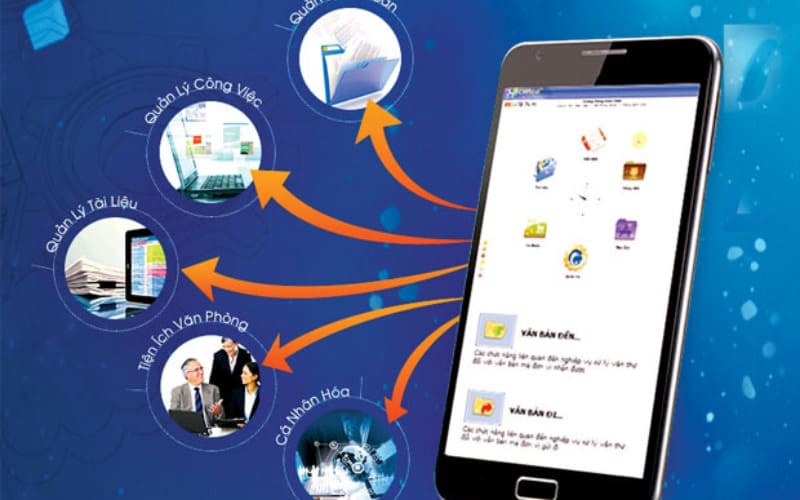
Step 4 – convey the message in conversion of digital transformation
All employees, investors and other business stakeholders also need to know and have the same confidence in your digital vision and strategy. Businesses can also take advantage of familiar communication tools such as corporate vision and mission statements, and turn them into digital vision and mission. However, it is still better not to separate the digital or “non-digital” mission. That message should be repeated regularly to reassure shareholders, while reaffirming commitment to the digitalization process.
Step 5 – Start with pilot projects
Once you have all the elements such as commitment, strategy, consensus and a dedicated digital team together, it's time to start implementing the digital project.
Instead of implementing a number of goods on the whole business, the risk of failure is high, businesses should aim at small targets, easy to carry through the pilot project. This helps to reinforce and reassure investors and employees, at the same time maximize the chance of success of the entire the phase shift of.
McKinsey has concluded that there are five aspects of the business digitalization process that can be used as a basis for investment decisions: Marketing and Distribution – Products and Services – Processes – Technology ecosystem – Supply chain .
Overall, this step focuses on the ability to prioritize resources. Based on your strategy, capabilities, available resources, cost-benefit analysis, and conclusions from management, you need to list the changes you want to happen first.
Step 6 – build the human element in the conversion of digital transformation
In addition to technology factors, implementing a digitalization strategy needs to be carried out by people with appropriate skills. You can recruit new employees with new digital skills for your business, or focus on developing the capabilities of existing employees.
Step 7 – Set up a new operating model
The final step in conversion of digital transformation this will ensure that the process of digitization of business you gradually go into orbit. Two essential elements in efforts to build a new operating model for business is culture digital and team related functions (cross-functional team).
- Digital culture: creating and nurturing the main values that make up digital culture, which are flexibility, open spirit, cooperation and willingness to take risks.
- Cross-functional teams: digital projects should be led by cross-functional teams from IT and other business functions, which may even include other representatives such as customers, suppliers or agencies. These teams must self-manage and take full ownership of the experiences, products and services they create. Forming cross-functional teams is an effective solution to stimulate new ideas because each member possesses different perspectives and skills.
Conversion of digital transformation is a journey that changed the entire operation of the business in the field of. The deployment of technology, process, method of operation is needed to survive and prosper in today's society. This is an opportunity for organizations to not only increase productivity but also improve the customer experience, leading to new opportunities, a break in the competition.
Work space of LV-DX Collaboration of the company shares Information, Lac Viet is a modern platform helps organizations optimize collaboration, project management, online in an effective way. With the tools multi-functional and versatile features, LV-DX Collaboration helps improve coordination of work, enhance the ability to meet the demand for rapid changes in the business environment today
CONTACT INFORMATION:
- Lac Viet Computing Corporation
- Hotline: (+84.28) 3842 3333
- Email: info@lacviet.vn – Website: www.lacviet.vn
- Headquarters: 23 Nguyen Thi Huynh, P. 8, Q. Phu Nhuan, Ho Chi Minh city

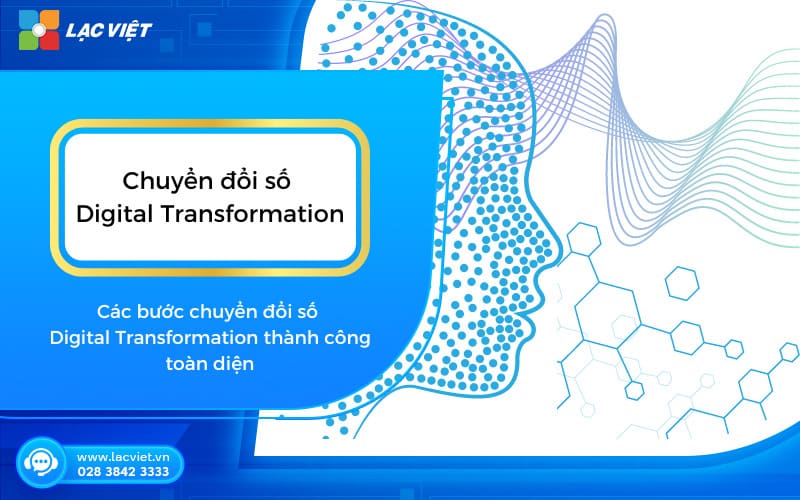
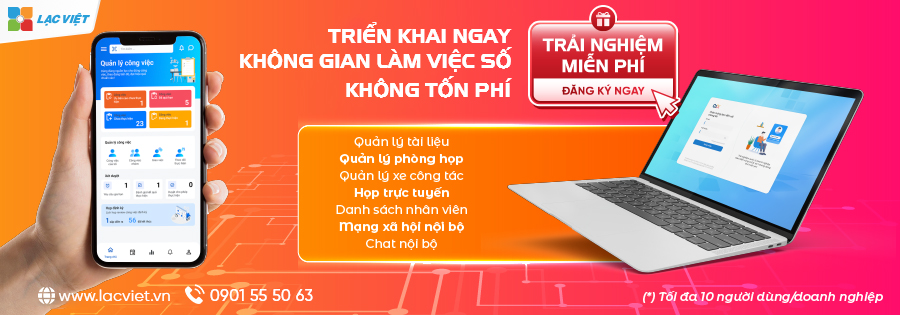


![Hệ thống hoạch định nguồn lực doanh nghiệp ERP [Tài liệu chuẩn]](https://lacviet.vn/wp-content/uploads/2025/02/he-thong-hoach-dinh-nguon-luc-doanh-nghiep.png)

